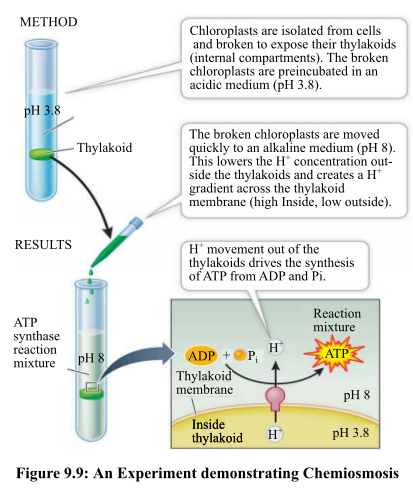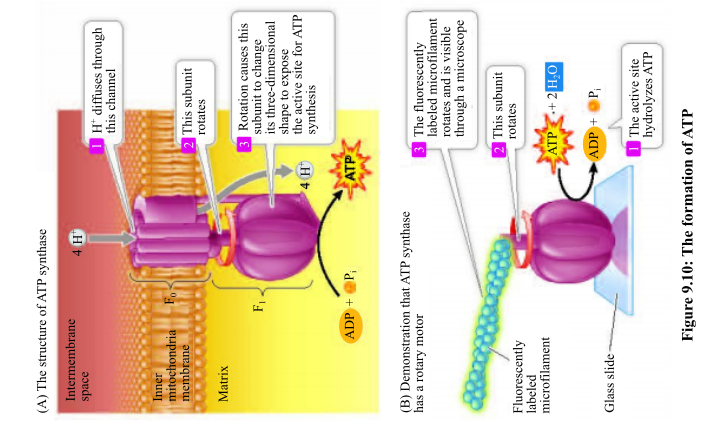
Concept explainers
To review:
The experiments described in Figures 1 and 2, which demonstrate the chemiosmotic mechanism.
Given:

Figure 1: An experiment to demonstrate chemiosmosis.

Figure 2A and B: The formation of adenosine triphosphate (ATP); (A) The structure of ATP synthase and (B) Demonstration that ATP synthase has a rotary motor.
Introduction:
Chemiosmosis is the second stage of the oxidative phosphorylation after the electron transport chain (ETC). As a result of the transport of electrons across the respiratory chain in ETC, a proton concentration gradient takes place to the intermembrane space from the mitochondrial matrix. In chemiosmosis, the production of adenosine triphosphate (ATP) occurs by the influx of the protons back into the matrix of the mitochondria.
Want to see the full answer?
Check out a sample textbook solution
Chapter 9 Solutions
Life: The Science of Biology
- In step 3 of today's protocol, it mentions that the incubation step with the P2 buffer should not be allowed to proceed for more than 5 minutes. a) What is the chemical composition and concentration (not mass) of each component of the P2 buffer?b) c) What is the purpose of adding the P2 buffer? What would be the major problem if this step is allowed to proceed for a long period of time?arrow_forwardWhat chemical ingredients make MSA differential? How (in your own words) do those chemical ingredients work to make this medium differential?arrow_forwardWhat salt did Meselson and Stahl use for their ultracentrifuge gradients? NaCI NH4CI CSCI O CaCl2arrow_forward
- What is the function of gas vesicles? How are thesestructures made such that they can remain gas tight?arrow_forward1 (a)Why is the spectrophotometer set at 0.000 absorbance for the uninoculated tube of broth? (B) Why can't you use the same plot (or standard curve) of plot of absorbance versus cell count for Escherichia coli for other bacteria? (C)List 3 advantages of estimating microbial numbers or biomass by the turbidimetric method? (C)(ii)List 2 disadvantages of this method? (D) Can you measure all kinds of microbes this way? Why not? ( this is not a graded assignment)arrow_forwardwhat is O2BIP? And how does it work?arrow_forward
- 1.). a.) What particular pathways or enzymes appear distinct for sulfate reducing bacteria in order to harness energy (create ATP)? b.) What interesting structures or unique characteristics allowed sulfate reducing bacteria to solve physical and/or chemical challenges/problems in conserving energy?arrow_forwardHow would you design the experiment to determine the CFUs/ml of obligate anaerobic bacterium?arrow_forwardYou got an opportunity to join a professor lab who is working in-vivo model and specifically looking at the dysregulation of mitochondria in liver. He asked you to isolate mitochondria from a Rat liver and placed in an assay medium. Based on the knowledge you gain in this course so far, please answer the following questions: a) Which technique will you use to isolate mitochondria? b) What happens to the pH of the medium when the medium is kept anaerobic? c) What happens when O2-saturated saline is added to the mixture?arrow_forward
- Why do boiled and unboiled potato extracts differ in their action on hydrogen peroxide? Explain in 1-3 sentencesarrow_forwardpropose a hypothesis regarding the organism (escherichia, staphylococcus, pseudomonas, bacillus) that will demonstrate greater resistance to UV and why? if the hypothesis is supported, what specific experimental results will be observed? and what serves as the control treatment?arrow_forwardHow are the Kato Katz Technique results reported?arrow_forward
 Principles Of Radiographic Imaging: An Art And A ...Health & NutritionISBN:9781337711067Author:Richard R. Carlton, Arlene M. Adler, Vesna BalacPublisher:Cengage Learning
Principles Of Radiographic Imaging: An Art And A ...Health & NutritionISBN:9781337711067Author:Richard R. Carlton, Arlene M. Adler, Vesna BalacPublisher:Cengage Learning


